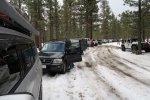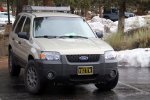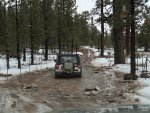BIG BEAR SNOW DAY CONTINUED!!!
Time for a new strategy.
I went back to the driver's door and crawled over the seat backs to get to my recovery gear. While I this technique was drier and warmer, my mucked up pants and boots were making a mess of my upholstery. I secured my recovery bag and lugged it back out the front.
The Escape's two front recovery points are somewhere between & trail rated and & just tie downs. To accommodate, I run a short tow rope through the recovery strap eye, then connect the tow rope ends to each recovery point. This bridle divides the load between the two recovery points.
About a dozen freshly plowed ice blocks needed removal before commencing with recovery. With the ice tossed aside, the Jeep gave a tug and out I popped. He pulled me up the next hill a bit to make room for the next rig. As I put away my recovery gear (and licked my emotional wounds), I watched the next rig drop into the pool.
He was looking good till he hit the ledge. Same as me, he popped up, nose high, and stopped with the front wheels clawing at the air. I never wish ill will on a fellow explorer, but seeing the next in line also have to be extracted from the icy clutches of this ruthless beast took a bit of the sting out of my failure.

It was time to get the front of the line going, so I didn't get to watch any other attempts at the ledge. At lunch I heard that there were a few more rigs that struggled with the ledge. It seems the built rigs ate it all up, while some of the stock rigs stumbled. I didn't feel so bad after that, (Despite my frigid, wet, pants continuing to test my frosticles )

.
Note to self: Next time, don't go second in line through deep ice-holes. Let the big boys clear the ? out of the way before you get there. Could I have scaled the step going later in line? Hmmm, probably not. But, going second in line, I had zero chance.
Next on the agenda, the group made a history stop at the cabin of one of the early settlers to the Big Bear area.



Later, we made a lunch stop and found the road ahead was closed. That means back tracking. That means meeting my nemesis ice-hole again. D'oh!!!

This time gravity was in my side. I can just fall down the step, no need to climb. Learning from my previous mistake, I carefully inserted my rig well back in the caravan. My worry now was dropping nose first, off the step, into engine suffocating water.
The dreaded ice-hole loomed ahead of me. I finally reached the step. No guts, no glory! I touch the throttle and drop the nose in. The water came over the hood briefly, but as the back end dropped over the ledge, the Escape leveled out. No drowning, no recovery needed!

As we continued, there were a few poorly placed rocks in the road. The road was too narrow to drive around them, and I wasn't sure if I could take them down the middle, so I did a li'l rock crawling. I eased my right tire up on the rock. That wasn't bad. I then continued gently over the back side of the rock... CRACK!!!
D'oh! There goes my over priced factory hard plastic mud flap! I had been thinking about removing them anyway. Now I had a reason. Fortunately the rock didn't reach my door sills. The back tire went up and over the rock, but this time spared the mudflap.

On the hill climbs, I observed a few of the straight axle rigs doing a bit of fish-tailing in the icy snow. I don't know if this was due to tires, suspension, or specialty differentials. The Escape impressively tracked straight in the snow throughout the trip. I didn't feel any slipping or sliding, even on the hills.

We finished the trip going around the back side of the mountain, then returning to the visitor center.

Conclusions:
-The Cooper AT3s proved their worth in the wet snow.
-The Escape continues to impress me with its ability to put traction where it is needed, (front to back).
-No water made it into the differentials or transfer case from the cold water crossings.
- While not a Wrangler, the Escape is still a fun and capable adventure vehicle.































